TAGGED: 3-d-model, eddy-currents, electromagnetic, magnetics, transient-analysis
-
-
April 16, 2021 at 7:33 am
dhruvdeshwal17
SubscriberGreetings,nFacing the error while doing the analysisnAnalysis - The copper plate and a magnet are placed adjacent to each other with a certain gap. A velocity is given to the plate (-0.1m/s) and the magnet remains stationary. So, as the plate move, the plate will see a change in a magnetic field by which eddy current will be generated in the plate and due to this current a magnetic field will be generated of opposite polarity as that of the magnet. Due to this generated magnetic field, the magnet experiences a force. I FMAGBC the copper plate and parallel flux as a boundary condition.nIn this analysis I have to calculate the eddy current generated in the copper plate and magnetic field generate the magnetic field due eddy current .nModel - n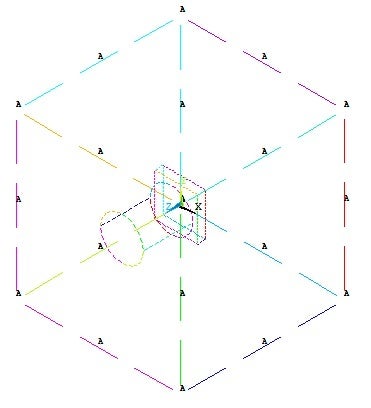 nnMarcos of the analysis.nfinin/clen/PREP7 nnC*************************************************n!Element Tablen nET,1,SOLID97n!* nET,2,SOLID97n!* nKEYOPT,1,1,1nKEYOPT,1,2,1nKEYOPT,1,5,0n!* nKEYOPT,1,1,1nET,3,SOLID97n!* nKEYOPT,3,1,0nKEYOPT,3,2,0nKEYOPT,3,5,0n!* n!* nKEYOPT,1,1,1nKEYOPT,1,2,1nKEYOPT,1,5,2n!* nKEYOPT,1,1,1nKEYOPT,2,1,0nKEYOPT,2,2,0nKEYOPT,2,5,2nn!Real Constant ValuenR,1,nRMORE, , , , ,0.1, ,nRMORE, , , , , ,n nC**************************************************n!Material PropertiesnMPTEMP,,,,,,,, nMPTEMP,1,0 nMPDATA,MURX,1,,1.2289 ! Permeability of magnetnMPTEMP,,,,,,,, nMPTEMP,1,0 nMPDATA,MGXX,1,, nMPDATA,MGYY,1,, nMPDATA,MGZZ,1,,9.26e5 !coercive force of magnet nMPTEMP,,,,,,,, nMPTEMP,1,0 nMPDATA,MURX,2,,0.999 ! Permeability of copper plate nMPTEMP,,,,,,,, nMPTEMP,1,0 nMPDATA,RSVX,2,,1.72e-8 ! Resistivity of copper platenMPTEMP,,,,,,,, nMPTEMP,1,0 nMPDATA,MURX,3,,1 ! Permeability of air nnC************************************************************************************n! GeometrynBLOCK,-0.013,0.013,-0.013,0.013,-0.0025,0.0025, ! copper plate nCYLIND,0.013, ,0.0055,0.0355,0,360, ! magnet nBLOCK,-0.05,0.05,-0.05,0.05,-0.05,0.05, ! enclosed area nnC*********************************************************************n! Overlap, Glue and Numbering Comp operation FLST,2,3,6,ORDE,2 nFITEM,2,1 nFITEM,2,-3 nVOVLAP,P51X nFLST,2,3,6,ORDE,3 nFITEM,2,1 nFITEM,2,-2 nFITEM,2,4 nVGLUE,P51X nNUMCMP,VOLUnnC************************************************************************n!Meshingn nTYPE, 1 nMAT, 2nREAL, 1 nESYS, 0 nSECNUM, n!* nMSHAPE,1,3D nMSHKEY,0n!* nCM,_Y,VOLU nVSEL, , , , 1 nCM,_Y1,VOLU nCHKMSH,'VOLU' nCMSEL,S,_Y n!* nVMESH,_Y1 n!* nCMDELE,_Y nCMDELE,_Y1 nCMDELE,_Y2 n!* nTYPE, 2 nMAT, 1nREAL, 1 nESYS, 0 nSECNUM, n!* nCM,_Y,VOLU nVSEL, , , , 2 nCM,_Y1,VOLU nCHKMSH,'VOLU' nCMSEL,S,_Y n!* nVMESH,_Y1 n!* nCMDELE,_Y nCMDELE,_Y1 nCMDELE,_Y2 n!* nTYPE, 3 nMAT, 3nREAL, 1 nESYS, 0 nSECNUM, n!* nCM,_Y,VOLU nVSEL, , , , 3 nCM,_Y1,VOLU nCHKMSH,'VOLU' nCMSEL,S,_Y n!* nVMESH,_Y1 n!* nCMDELE,_Y nCMDELE,_Y1 nCMDELE,_Y2 n!* nnC****************************************n!Flag copper platennALLSEL,ALL nVSEL,S, , , 1 nESLV,S nCM,A,ELEM n!* n!* nFMAGBC,'A' nFLST,2,6,5,ORDE,2 nFITEM,2,11 nFITEM,2,-16 nDA,P51X,ASYMnALLSEL,ALL nFINISHnC***********************************************n! Transient Solutionn/SOLn!* nANTYPE,4n!* nTRNOPT,FULL n!* nDELTIM,0.002,0,0nOUTRES,ERASEnOUTRES,ALL,ALL nKBC,0 nTIME,0.01 n/STATUS,SOLUnSOLVE nAttaching the elements used in the analysisnElement ref 1 - for coppernElement ref 2 - for permanent magnetnElement ref 3 - for airn
nnMarcos of the analysis.nfinin/clen/PREP7 nnC*************************************************n!Element Tablen nET,1,SOLID97n!* nET,2,SOLID97n!* nKEYOPT,1,1,1nKEYOPT,1,2,1nKEYOPT,1,5,0n!* nKEYOPT,1,1,1nET,3,SOLID97n!* nKEYOPT,3,1,0nKEYOPT,3,2,0nKEYOPT,3,5,0n!* n!* nKEYOPT,1,1,1nKEYOPT,1,2,1nKEYOPT,1,5,2n!* nKEYOPT,1,1,1nKEYOPT,2,1,0nKEYOPT,2,2,0nKEYOPT,2,5,2nn!Real Constant ValuenR,1,nRMORE, , , , ,0.1, ,nRMORE, , , , , ,n nC**************************************************n!Material PropertiesnMPTEMP,,,,,,,, nMPTEMP,1,0 nMPDATA,MURX,1,,1.2289 ! Permeability of magnetnMPTEMP,,,,,,,, nMPTEMP,1,0 nMPDATA,MGXX,1,, nMPDATA,MGYY,1,, nMPDATA,MGZZ,1,,9.26e5 !coercive force of magnet nMPTEMP,,,,,,,, nMPTEMP,1,0 nMPDATA,MURX,2,,0.999 ! Permeability of copper plate nMPTEMP,,,,,,,, nMPTEMP,1,0 nMPDATA,RSVX,2,,1.72e-8 ! Resistivity of copper platenMPTEMP,,,,,,,, nMPTEMP,1,0 nMPDATA,MURX,3,,1 ! Permeability of air nnC************************************************************************************n! GeometrynBLOCK,-0.013,0.013,-0.013,0.013,-0.0025,0.0025, ! copper plate nCYLIND,0.013, ,0.0055,0.0355,0,360, ! magnet nBLOCK,-0.05,0.05,-0.05,0.05,-0.05,0.05, ! enclosed area nnC*********************************************************************n! Overlap, Glue and Numbering Comp operation FLST,2,3,6,ORDE,2 nFITEM,2,1 nFITEM,2,-3 nVOVLAP,P51X nFLST,2,3,6,ORDE,3 nFITEM,2,1 nFITEM,2,-2 nFITEM,2,4 nVGLUE,P51X nNUMCMP,VOLUnnC************************************************************************n!Meshingn nTYPE, 1 nMAT, 2nREAL, 1 nESYS, 0 nSECNUM, n!* nMSHAPE,1,3D nMSHKEY,0n!* nCM,_Y,VOLU nVSEL, , , , 1 nCM,_Y1,VOLU nCHKMSH,'VOLU' nCMSEL,S,_Y n!* nVMESH,_Y1 n!* nCMDELE,_Y nCMDELE,_Y1 nCMDELE,_Y2 n!* nTYPE, 2 nMAT, 1nREAL, 1 nESYS, 0 nSECNUM, n!* nCM,_Y,VOLU nVSEL, , , , 2 nCM,_Y1,VOLU nCHKMSH,'VOLU' nCMSEL,S,_Y n!* nVMESH,_Y1 n!* nCMDELE,_Y nCMDELE,_Y1 nCMDELE,_Y2 n!* nTYPE, 3 nMAT, 3nREAL, 1 nESYS, 0 nSECNUM, n!* nCM,_Y,VOLU nVSEL, , , , 3 nCM,_Y1,VOLU nCHKMSH,'VOLU' nCMSEL,S,_Y n!* nVMESH,_Y1 n!* nCMDELE,_Y nCMDELE,_Y1 nCMDELE,_Y2 n!* nnC****************************************n!Flag copper platennALLSEL,ALL nVSEL,S, , , 1 nESLV,S nCM,A,ELEM n!* n!* nFMAGBC,'A' nFLST,2,6,5,ORDE,2 nFITEM,2,11 nFITEM,2,-16 nDA,P51X,ASYMnALLSEL,ALL nFINISHnC***********************************************n! Transient Solutionn/SOLn!* nANTYPE,4n!* nTRNOPT,FULL n!* nDELTIM,0.002,0,0nOUTRES,ERASEnOUTRES,ALL,ALL nKBC,0 nTIME,0.01 n/STATUS,SOLUnSOLVE nAttaching the elements used in the analysisnElement ref 1 - for coppernElement ref 2 - for permanent magnetnElement ref 3 - for airn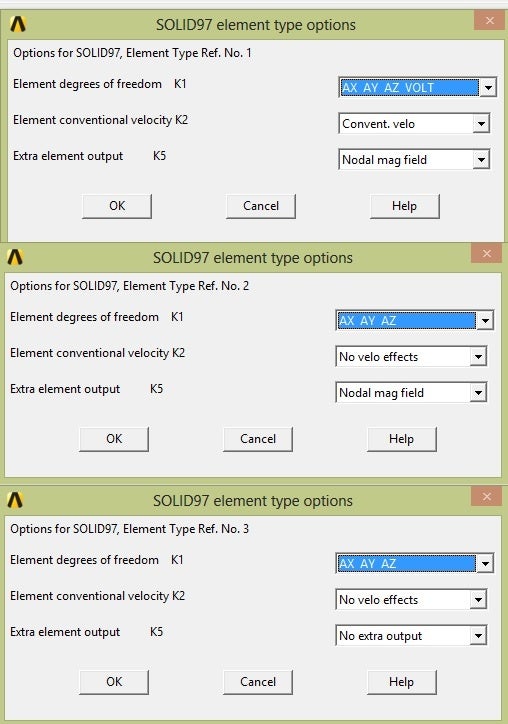 n Errorn
n Errorn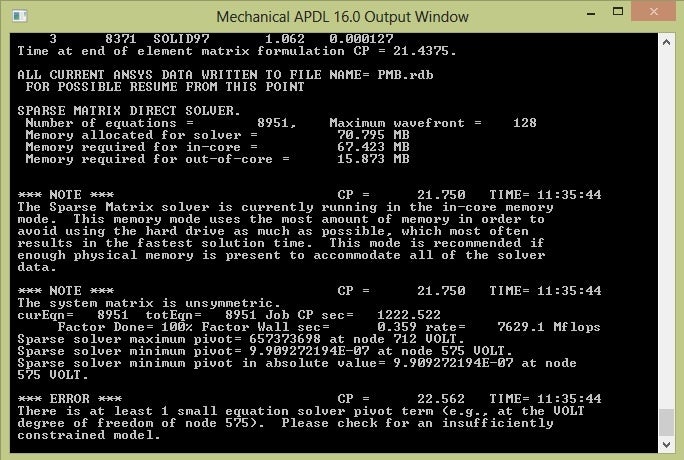 nNote - Some suggested to use SOLID236 element, but there are some papers which have calculated the results by using the SOLID97 even with more complicated model than this (Ex - https://www.scielo.br/scielo.php?pid=S1679-78252016001101997&script=sci_arttext). This is hypothetical model just to calculate the the various parameters, later use this concept for complicated models .nAs per the my understanding the problem might in the elements types option or loading nPlease suggest if any constrained is not defined or if any change required in the model. nYour Sincerely
nNote - Some suggested to use SOLID236 element, but there are some papers which have calculated the results by using the SOLID97 even with more complicated model than this (Ex - https://www.scielo.br/scielo.php?pid=S1679-78252016001101997&script=sci_arttext). This is hypothetical model just to calculate the the various parameters, later use this concept for complicated models .nAs per the my understanding the problem might in the elements types option or loading nPlease suggest if any constrained is not defined or if any change required in the model. nYour Sincerely
-
April 21, 2021 at 6:28 pm
wrbulat
Ansys EmployeeHi,nSee if turning off pivot checking helps. To do this, use the PIVC,OFF command prior to the SOLVE command. I have yet to see a case in which disabling pivot checking causes an erroneous emag solution, so chances are very good it should be OK to do this.nStrictly speaking, the modeled representation of the moving electrically conductive domain (in your case the plate) is supposed to be continuous in the direction of motion for the velocity effect to be valid:n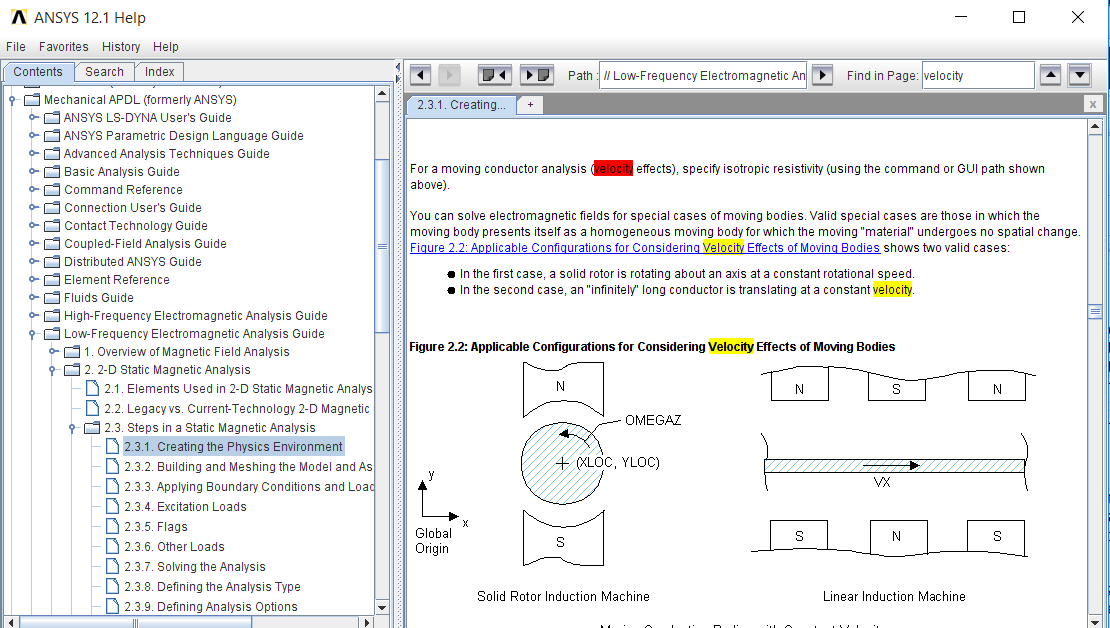 Your modeled representation of the plate appears to have a finite length. If you need it to remain so, try to find a way to validate the results you obtain (e.g., see if the induced eddy currents are normal to the plate boundaries). nAlso, depending of the velocity and electrical resistivity of the conductor, the mesh may need to be refined so that the resulting magnetic Reynold's number isn't too high:n
Your modeled representation of the plate appears to have a finite length. If you need it to remain so, try to find a way to validate the results you obtain (e.g., see if the induced eddy currents are normal to the plate boundaries). nAlso, depending of the velocity and electrical resistivity of the conductor, the mesh may need to be refined so that the resulting magnetic Reynold's number isn't too high:n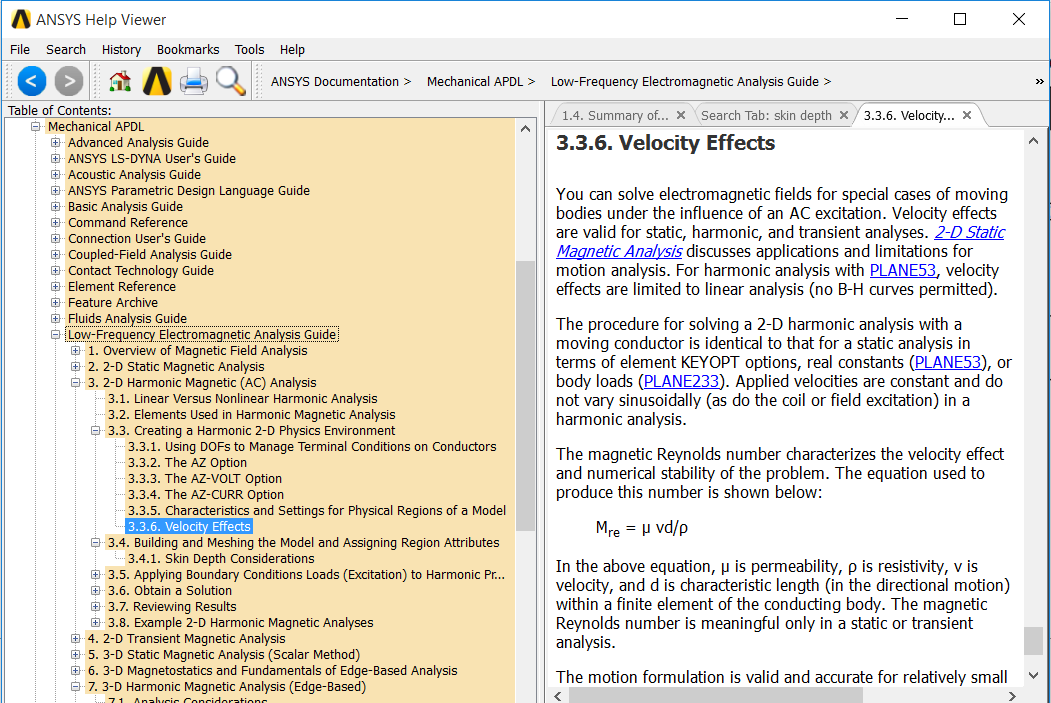 nLastly, the nodal based MVP (magnetic vector potential) formulation used by legacy SOLID97 element type can produce erroneously calculated fields on material interfaces between domains that have very different magnetic permeabilities (e.g., iron and air). This is due to the fact that the MVP forces the tangential component of B to be continuous on the interface. Physically, there is a discontinuous jump in the tangential component of B at such an interface. The edge-flux formulation used by the new technology SOLID236/237 properly addresses the field at such interfaces. If the PM is Neodymium, then it has a permeability that is quite close to that of free space and the error might be acceptably small. If the permeability of the PM is high, you should probably consider using new technology SOLID236/237.nOh, one additional thing. When using the FMAGSUM command to get the plate force, the forces determined by the virtual displacement method are typically more accurate than those obtained using the Maxwell stress tensor. But more accurate than either of these (as long as the conductive body is not permeable, as is the case for Copper) is a summation of the Lorentz forces. You can select the plate elements and read in the x, y, and z components of FMAG into the element table (these should be the volumetrically distributed Lorentz forces in the plate at element centroids) and use the SSUM command to obtain total values for the selected elements.I hope this helps,Best,Bill
nLastly, the nodal based MVP (magnetic vector potential) formulation used by legacy SOLID97 element type can produce erroneously calculated fields on material interfaces between domains that have very different magnetic permeabilities (e.g., iron and air). This is due to the fact that the MVP forces the tangential component of B to be continuous on the interface. Physically, there is a discontinuous jump in the tangential component of B at such an interface. The edge-flux formulation used by the new technology SOLID236/237 properly addresses the field at such interfaces. If the PM is Neodymium, then it has a permeability that is quite close to that of free space and the error might be acceptably small. If the permeability of the PM is high, you should probably consider using new technology SOLID236/237.nOh, one additional thing. When using the FMAGSUM command to get the plate force, the forces determined by the virtual displacement method are typically more accurate than those obtained using the Maxwell stress tensor. But more accurate than either of these (as long as the conductive body is not permeable, as is the case for Copper) is a summation of the Lorentz forces. You can select the plate elements and read in the x, y, and z components of FMAG into the element table (these should be the volumetrically distributed Lorentz forces in the plate at element centroids) and use the SSUM command to obtain total values for the selected elements.I hope this helps,Best,Bill
-
April 22, 2021 at 7:42 am
dhruvdeshwal17
SubscriberThank you! for your guidance .n
-
Viewing 2 reply threads
- The topic ‘* Error* there is at least 1 small equation solver pivot term (eg. VOLT DOF of node 575)’ is closed to new replies.
Innovation Space


Trending discussions


- Three-Phase Voltage Imbalances in dual stator electric generator
- Co-simulation in Q3D, Icepak – meshing problem
- Classic Icepak – clarifications on Boundary condition
- Link the Circuit to 3D Terminals
- Magnetic Dipole moment calculation
- Integration lines or U Axis Line for circular and rectangular ports
- Core Loss in ANSYS MAXWELL Eddy Current solution
- exporting and importing my Netlist for my external circuit
- Error of Metal Fraction in Icepak Classic.
- The unit of theta in Is*sin(2*pi*fre*Time+theta-2*pi/3)
Top Contributors


-
4597
-
1495
-
1386
-
1209
-
1021
Top Rated Tags


© 2025 Copyright ANSYS, Inc. All rights reserved.
Ansys does not support the usage of unauthorized Ansys software. Please visit www.ansys.com to obtain an official distribution.







